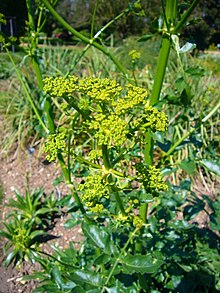Opopanax (genus)
| Opopanax | |
|---|---|

| |
| Opopanax chironium | |
| Scientific classification | |
| Kingdom: | Plantae |
| Clade: | Tracheophytes |
| Clade: | Angiosperms |
| Clade: | Eudicots |
| Clade: | Asterids |
| Order: | Apiales |
| Family: | Apiaceae |
| Subfamily: | Apioideae |
| Genus: | Opopanax W.D.J.Koch |
Opopanax is a genus of plants in the family Apiaceae.
Species
Opopanax include four species:[1]
- Opopanax chironium (L.) W.D.J.Koch
- Opopanax hispidus (Friv.) Griseb.
- Opopanax persicus Boiss.
- Opopanax siifolius (Boiss. & Heldr.) Menemen
Etymology
The genus name Opopanax derives from Anglo-Norman opopanac, from Latin opopanax, from Hellenistic Greek ὀποπάναξ, from Ancient Greek ὀπός (opos, "juice") + πάναξ (panax, "all-healing").[2] Therefore, opopanax literally means the juice (gum resin) of all-heal. There were many different plants called all-heal (πάνακες or panaces) in Ancient Greece and Rome. However, according to Dioscorides, opopanax was obtained specifically from a kind of all-heal named πάνακες Ἡράκλειον (panaces Heraclion, "Hercules' all-heal"), which has been identified as Opopanax chironium,[3][4][5] O. persicus[5] and O. hispidus.[6]
The term opopanax traditionally refers to the medicinal gum resin of Opopanax sp., but in perfumery, opopanax refers to the gum resin of an unrelated species Commiphora guidottii.[5]
Taxonomic history
The genus was created by Wilhelm Koch based on the species Opopanax chironium, previously known as Pastinaca opopanax L. and Ferula opopanax Spreng.[7]
References
- ^ "Opopanax siifolius (Boiss. & Heldr.) Menemen". Plants of the World Online. Kew Science. Retrieved 2020-08-29.
- ^ "opopanax". Oxford English Dictionary. Retrieved 2009-12-27. (subscription required)
- ^ Dioscorides, Pedanius (1902). Des Pedanios Dioskurides aus Anazarbos. Translated by Julius Berendes. Stuttgart, Germany: Verlag von Ferdinand Enke. pp. 295–297.
- ^ Royle, John Forbes (1847). Carson, Joseph (ed.). Materia Medica and Therapeutics: Including the Preparations of the Pharmacopoeias of London, Edinburgh, Dublin, and (of the United States) with Many New Medicines. Philadelphia, US: Lea and Blanchard. p. 405.
- ^ a b c Thulin, Mats; Claeson, Per (1991). "The Botanical Origin of Scented Myrrh (Bissabol or Habak Hadi)". Economic Botany. 45 (4): 487–494. doi:10.1007/BF02930711. ISSN 0013-0001. JSTOR 4255391.
- ^ Dioscorides, Pedanius (2017). De materia medica. Translated by Lily Y. Beck (3rd ed.). Hildesheim, Germany: Georg Olms Verlag. ISBN 9783487155715.
- ^ "Generum Tribuumque plantarum umbelliferarum nova dispositio". Nova Acta Physico-Medica Academiae Caesareae Leopoldino-Carolinae Naturae Curiosum. 12 (1): 55–156 (on page 96). Retrieved 8 June 2014.
